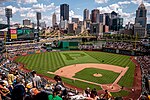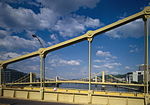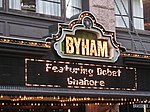Statue of Roberto Clemente (Pittsburgh)
1994 sculpturesBronze sculptures in PennsylvaniaMonuments and memorials in PittsburghSculptures of men in PennsylvaniaStatues in Pennsylvania ... and 2 more
Statues of sportspeopleUnited States sculpture stubs

In 1994, the Pittsburgh Pirates unveiled a 12-foot statue of Baseball Hall of Fame outfielder Roberto Clemente, just before the 1994 Major League Baseball All-Star Game which was hosted by the Pirates in Three Rivers Stadium.
Excerpt from the Wikipedia article Statue of Roberto Clemente (Pittsburgh) (License: CC BY-SA 3.0, Authors, Images).Statue of Roberto Clemente (Pittsburgh)
Roberto Clemente Bridge, Pittsburgh
Geographical coordinates (GPS) Address Nearby Places Show on map
Geographical coordinates (GPS)
| Latitude | Longitude |
|---|---|
| N 40.446805555556 ° | E -80.003944444444 ° |
Address
Roberto Clemente Statue
Roberto Clemente Bridge
15222 Pittsburgh
Pennsylvania, United States
Open on Google Maps











